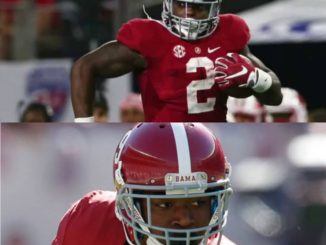
BIRMINGHAM, Ala. — The Southeastern Conference dropped a bombshell on today that has fans from Tuscaloosa to The Plains reeling: For the first time in over five decades, the legendary Iron Bowl college football’s most venomous rivalry will collide in mid-October, not as the capstone of rivalry week.
The 2026 schedule, unveiled during a glitzy SEC Network special, slots Alabama at Auburn on October 17, a full six weeks ahead of the traditional late-November slot. It’s a seismic pivot designed to “optimize competitive balance and playoff positioning,” per league commissioner Greg Sankey, but to diehards on both sides, it’s nothing short of sacrilege.
The announcement, timed to coincide with the SEC’s multi-year opponents reveal for 2026-2029, protects the annual Alabama-Auburn matchup as one of each team’s three protected rivals alongside Tennessee for the Tide and Georgia for the Tigers.

Yet, by baking it into the 3-4-5-5 format (three permanent foes, four rotating divisional games, and five cross-divisional clashes), the SEC has jettisoned the end-of-season drama that has defined the Iron Bowl since 1948. The last non-November edition? 1973, when Alabama edged Auburn 24-0 on October 13—a dusty footnote in a rivalry that has since become synonymous with turkey leftovers, family feuds, and national title implications.
“This isn’t just a schedule tweak; it’s an assault on tradition,” thundered Paul Finebaum, ESPN’s SEC oracle and Alabama alum, on his eponymous radio show Wednesday morning. “The Iron Bowl isn’t a game—it’s Thanksgiving. It’s Bear Bryant staring down Shug Jordan under those Jordan-Hare lights while half of Alabama holds its breath. Mid-October? That’s tailgate weather for a cupcake game, not Armageddon.”
In Tuscaloosa, Crimson Tide boosters circulated a petition demanding Sankey’s ouster, amassing 25,000 signatures by midday. “We’ve endured scandals, scandals, and Saban’s retirement,” one anonymous donor told AL.com. “But this? It’s like moving the Fourth of July to Flag Day.”
The roots of this upheaval trace back to the SEC’s 2024 expansion convulsions, when Oklahoma and Texas joined the fray, bloating the league to 16 teams and axing divisions. Sankey, ever the data-driven diplomat, touted the shift as a “strategic evolution” to mitigate late-season fatigue and boost television ratings through staggered marquee matchups.
“By distributing rivalries across the calendar, we’re ensuring every weekend is must-see TV,” he said in a presser. “The Iron Bowl’s intensity won’t fade—it’s just arriving fashionably early.”
Critics, however, see dollar signs over destiny. With the College Football Playoff expanding to 12 teams, Sankey argued that an October Iron Bowl allows both squads to heal from bruises before a grueling November sprint think Alabama dodging a potential LSU gauntlet or Auburn navigating Georgia late.
But whispers from league sources suggest the real driver is revenue: Midseason prime-time slots on ESPN could command $10 million more in ad dollars than a Thanksgiving afternoon kickoff, especially with flex scheduling in play.
Auburn head coach Hugh Freeze, fresh off a 9-4 campaign that included a Music City Bowl rout, struck a pragmatic tone. “Tradition matters, but championships don’t wait for turkey,” Freeze told reporters post-practice. “An early Iron Bowl means we can focus on execution without the holiday hangover. Plus, beating Bama in October? That’s just more time to celebrate.”
His counterpart, Alabama’s Kalen DeBoer, was more measured: “We’re 0-1 against Auburn on my watch. Date doesn’t change the stakes—it’s still blood for blood.” DeBoer, navigating his second season after a 10-3 debut marred by a Peach Bowl loss, views the shift as a chance to reset narratives. Yet, even he couldn’t hide a grimace when asked about Thanksgiving plans: “Family time, I guess. Without the cowbells.”
Fan reactions paint a vivid portrait of divided loyalties. In Auburn, where Jordan-Hare Stadium’s north end zone once hosted a cannon named “Thunder,” locals are split. “It’s heresy,” lamented 72-year-old retiree and 1967 alumnus Harlan “Bo” Whitaker, nursing a beer at War Eagle Cafe.
“My daddy took me to the ’77 game—Bo Jackson’s freshman year. Snow on the field, magic in the air. October’s just humid.” But younger Tigers, like 22-year-old student Emily Hargrove, see upside: “Less pressure means more fun. We can trash-talk all fall without the national spotlight.”
Tuscaloosa’s fury burns hotter. At the Houndstooth Hangout bar, a mock “funeral” for the late-November Iron Bowl drew 300 mourners in crimson, complete with eulogies quoting Bear Bryant’s “pigs is pigs” wisdom. “Sankey’s turning our dynasty into a calendar app,” scoffed one chant.
The ripple effects extend beyond the state line. National pundits like Kirk Herbstreit decried the move on ESPN’s College GameDay, warning it erodes the “soul of the SEC.” Analysts project a 15% dip in Iron Bowl viewership if it slots against NFL crossovers, though Sankey counters with data: Early rivalries like Florida-Georgia (now potentially October) have spiked engagement in pilot years. Still, for a rivalry that has delivered 85 meetings, seven overtime thrillers, and icons from Cam Newton to Derrick Henry, the change feels like exile.



Be the first to comment